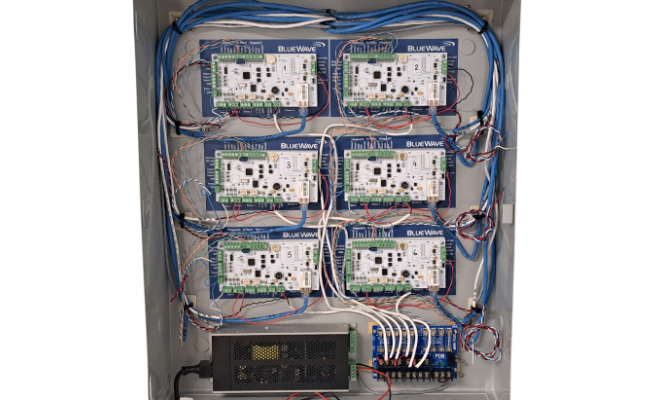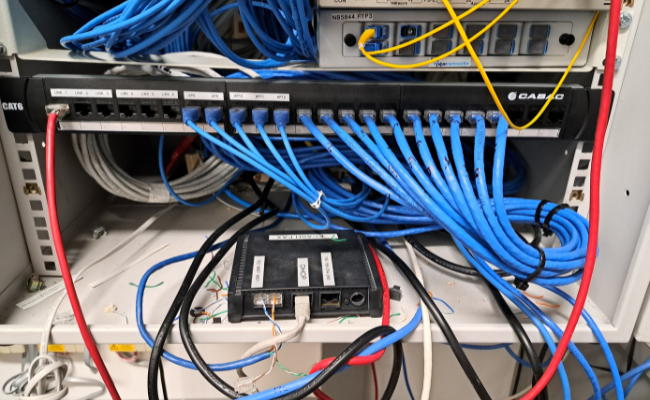When it comes to access control systems, two of the most popular protocols are Wiegand and OSDP (Open Supervised Device Protocol). Both of these protocols have their own advantages and disadvantages, and it can be difficult to decide which one is best for a given application. To help you make an informed decision, we’ll look at the differences between Wiegand and OSDP.

WIEGAND
Wiegand has been around since the 1980s, and is widely used in access control systems. It is a simple and reliable protocol that is easy to implement and troubleshoot. It is based on a two-wire system, with one wire for power and the other for data transmission. Wiegand is widely supported by access control systems and is relatively inexpensive to install and maintain. It is a simple and cost effective way to provide security for access control systems. Here are the main points about Wiegand:
- Two-Wire System: Wiegand is based on a two-wire system, which consists of a data wire and a ground wire.
- Data & Ground Wires: The data wire carries the data from the card reader to the access control panel, while the ground wire ensures that the data is not corrupted.
- Flexible card formats: Wiegand supports a variety of card readers, including the popular proximity cards, magnetic stripe cards, barcode cards, and fingerprint readers.
- Secure: Wiegand can be used to transfer up to 32 bits of data, allowing for a high level of security.
- Cost Effective: Wiegand is widely used in access control systems because of its cost effectiveness, ease of use, and high security capabilities.
|
Wiegand |
|
| Pro’s | Con’s |
| Wiegand Access control is a secure and reliable system that can be used to control access to a variety of locations. | Wiegand access control systems require dedicated wiring, which can be expensive and time-consuming to install. |
| It is user-friendly, with a simple programming process that requires minimal technical expertise that makes it easy to install and manage. | It is vulnerable to tampering as the wiring is relatively easy to access and manipulate. |
| It offers a variety of access control options, including card readers, biometric readers, and keypads. | It is not suitable for all types of locations, as it may be too bulky or too sophisticated for some environments. |
| It is an affordable and cost-effective solution. | It is not compatible with some types of hardware or software. |
| It is highly customizable, allowing for the creation of access schedules as well as integration of other systems. | It might require a high initial investment. |
| It can be used in combination with other security measures, such as CCTV surveillance and intrusion detection systems. | It can be prone to technical glitches or malfunctions. |
| Wiegand access control is highly secure, offering reliable authentication and encryption of data. | The system is prone to interference from other electronic equipment, which can cause malfunctions or false readings. |
| Wiegand access control is an industry standard, with a wide range of compatible devices and systems. | Depending on the complexity of the system, it can be difficult to troubleshoot and diagnose without the help of a technician. |

OPEN SUPERVISED DEVICE PROTOCOL (OSDP)
OSDP (Open Supervised Device Protocol) is a newer protocol, developed by the Security Industry Association in 2012. It is based on a four-wire system, with two wires for power and two for data transmission. OSDP is more secure than Wiegand, as it uses a 128-bit encryption algorithm and can authenticate the reader and card. It is also more flexible, as it supports up to 64 readers and 256 cards on a single bus. However, OSDP is more expensive to implement and maintain than Wiegand. It is designed to provide a secure and reliable connection for the exchange of access control data. The main points about OSDP protocols are as follows:
- Bi-directional authentication and encryption: OSDP supports bi-directional authentication and encryption to ensure secure communication between access control systems and peripheral devices.
- Secure data exchange: OSDP is designed to provide a secure connection for the exchange of access control data, which prevents unauthorized access and data manipulation.
- High-speed communication: OSDP provides high-speed communication between access control systems and peripheral devices, allowing for real-time monitoring and control of access control systems.
- Flexible card formats: OSDP supports a variety of card formats, including proximity cards, magnetic stripe cards, and smart cards.
- Compatibility: OSDP is compatible with a variety of access control systems and peripheral devices, making it a versatile and reliable protocol for access control.
|
OSDP (Open Supervised Device Protocol) |
|
| Pro’s | Con’s |
| OSDP provides a secure and reliable communication protocol for access control systems. | OSDP is not as widely supported as other access control systems and may not be compatible with all systems. |
| It is an open standard, which makes it easier for vendors to interoperate with each other and it provides support for multiple devices. | It is not as secure as some other access control systems such as ones that use digital certificates. |
| OSDP is easy to configure and use, making it ideal for small businesses. | It can be more difficult to troubleshoot than other access control systems, as it requires specific knowledge and expertise. |
| It supports multiple levels of security measures, such as card readers, biometrics, and encryption. | OSDP may require additional hardware and software to be installed, which can increase cost and complexity. |
| OSDP is more cost-effective than other access control systems. | OSDP is not compatible with some legacy divides. This could be a problem for existing access control systems that rely on those devices. |
| It supports ES-128 encryption which is the highest level of encryption available today. | OSDP requires more complex programming than other protocols, which could be a challenge for users who are not familiar with the technology. |
Both Wiegand and OSDP are reliable protocols used in access control systems. While Wiegand is cheaper and easier to implement, OSDP is more secure and flexible. Ultimately, the best protocol for your application will depend on your budget and security needs.

